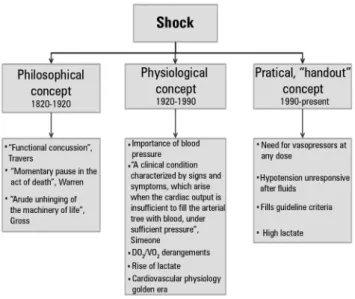Rev Bras Ter Intensiva. 2013;25(4):263-264
Lactate, blood pressure and infection: tied by faith,
untied by man?
EDITORIAL
"Diseases are conceptually all alike, although each syndrome is cumbersome in its own way". his paraphrase of the beginning sentence of Tolstoi's Anna Kareninna emphasizes the complexity of dealing with a kaleidoscopic mix of signs and symptoms and their interplay. Syndromes are a mainstay of critical care medicine; no other medical specialty deals more regularly with syndromes than intensive care unit (ICU) physicians. Critical illness itself could be considered a syndrome, regardless of its etiology.
Shock is one of the most fascinating syndromes described.(1) Shock
was first described in almost philosophical reports starting in the early nineteenth century, then passed through the "decades of measurement" when it was first studied on physiological grounds, and finally arrived at an age when simple, practical concepts are frequently employed to facilitate patient grouping and prognostication (Figure 1).(1) This current
approach to medicine should theoretically hasten the development of new therapies, but it can also result in categorization that ignores the initial philosophical and physiological concepts of a syndrome. The same process has occurred with many other syndromes (sepsis, acute respiratory distress syndrome, etc.).(2,3)
Sepsis and shock are interrelated syndromes.(3) As early as 1868, Edwin
Morris wrote that "hus it would seem that shock and putrid infection, meet hounds of death, hunted this unfortunate man, as it were, in couples: shock held him down while pyaemia fastened her poisoned fangs".
(4) In this context, the work presented by Ranzani et al.(5) in this issue of
Revista Brasileira de Terapia Intensiva is a breath of fresh air that may help us remember both the philosophical and physiological components of the interplay between shock and sepsis, as well as why we should always revisit the criteria used to diagnose a given syndrome. After categorizing a large sample of patients into four groups according to lactate levels and the presence of hypotension, the authors concluded that dysoxic shock (deined as both hypotension and hyperlactatemia) presented with higher mortality. In addition, patients with cryptic shock (i.e., normal blood pressure and high lactate levels) and vasoplegic shock presented with an intermediate mortality between patients with severe sepsis and dysoxic shock.
Several important conclusions from this study highlight the relevance of this work. Most importantly, these indings stress that one should not expect a clear association between hypotension and hyperlactatemia. Even cardiac
Fernando Godinho Zampieri1,2
1. Intensive Care Unit, Emergency Medicine Discipline, Hospital das Clínicas, Faculdade de Medicina, Universidade de São Paulo - USP - São Paulo (SP), Brazil.
2. Intensive Care Unit, Hospital Alemão Oswaldo Cruz - São Paulo (SP), Brazil.
Conflicts of interest: None.
Corresponding author: Fernando Godinho Zampieri
Intensive Care Unit, Hospital das Clínicas, 6th
floor, room
Avenida Doutor Enéas Carvalho de Aguiar, 23 Zip code: 05403-000 - São Paulo (SP), Brazil E-mail: fgzampieri@gmail.com
Lactato, pressão arterial e infecção: unidos pela fé, desunidos pelo
homem?
264 Zampieri FG
Rev Bras Ter Intensiva. 2013;25(4):263-264
output, which is the driving force determining blood pressure, may be unrelated to lactate levels.(6) Moreover,
both hypotension and hyperlactatemia relect an unhinging of the body's machinery, according to Gross,(7)
but they may also relect malfunctioning of diferent parts of the system. Hypotension can be summarized as a derangement of ventricle-arterial coupling that may arise both from reduced cardiac power and/or arterial elastance.(8) he role of lactate is much more complex,
but it is now clear that anaerobiosis is not the only mechanism involved,(9) as microcirculation disorders
and malfunctioning of the biochemical apparatus of the cell have also been shown to be important.(8) herefore,
because these phenomena have a unique physiological background, it is expected that their associations with outcome will be independent, and Ranzani's work corroborates this concept.(5)
Finally, the authors present extremely relevant indings regarding the epidemiology and prognosis of severe sepsis in our country. It is important to emphasize that the mortality rates due to severe sepsis and cryptic shock (16.8% and 35.2%, respectively) were similar to reports from developed countries.(10) his inding suggests that
when widely accepted practices are applied, positive results can be obtained irrespective of the hemisphere where the patient is treated.(11)
REFERENCES
1. Manji RA, Wood KE, Kumar A. The history and evolution of circulatory shock. Crit Care Clin. 2009;25(1):1-29, vii.
2. Ware LB, Matthay MA. The acute respiratory distress syndrome. N Engl J Med. 2000;342(18):1334-49. Review.
3. Funk DJ, Parrillo JE, Kumar A. Sepsis and septic shock: a history. Crit Care Clin. 2009;25(1):83-101, viii.
4. Morris E. A practical treatise of shock after surgical operations and injuries: with especial reference to shock caused by railway accidents. Philadelphia: Lippincott; 1868.
5. Ranzani OT, Monteiro MB, Ferreira EM, Santos SR, Machado FR, Noritomi DT. Reclassificando o espectro de pacientes sépticos com o uso do lactato: sepse grave, choque críptico, choque vasoplégico e choque disóxico. Rev Bras Ter Intensiva. 2013;25(4):xxx-xx.
6. Hernandez G, Bruhn A, Castro R, Pedreros C, Rovegno M, Kattan E, et al. Persistent sepsis-induced hypotension without hyperlactatemia: a distinct clinical and physiological profile within the spectrum of septic shock. Crit Care Res Pract. 2012;2012:536852.
7. Gross SD. A system of surgery: pathological, diagnostic, therapeutique and operative. Philadelphia: Blanchard and Lea; 1862.
8. Guarracino F, Baldassarri R, Pinsky MR. Ventriculo-arterial decoupling in acutely altered hemodynamic states. Crit Care. 2013;17(2):213. 9. Gladden LB. Lactate metabolism: a new paradigm for the third millennium.
J Physiol. 2004;558(Pt 1):5-30.
10. Gaieski DF, Edwards JM, Kallan MJ, Carr BG. Benchmarking the incidence and mortality of severe sepsis in the United States. Crit Care Med. 2013;41(5):1167-74.
11. Noritomi DT, Ranzani OT, Monteiro MB, Ferreira EM, Santos SR, Leibel F, et al. Implementation of a multifaceted sepsis education program in an emerging country setting: clinical outcomes and cost-effectiveness in a long-term follow-up study. Intensive Care Med. 2013 Oct 22. [Epub ahead of print].
